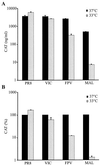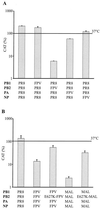Residue 627 of PB2 is a determinant of cold sensitivity in RNA replication of avian influenza viruses
- PMID: 11333924
- PMCID: PMC114948
- DOI: 10.1128/JVI.75.11.5398-5404.2001
Residue 627 of PB2 is a determinant of cold sensitivity in RNA replication of avian influenza viruses
Abstract
Human influenza A viruses replicate in the upper respiratory tract at a temperature of about 33 degrees C, whereas avian viruses replicate in the intestinal tract at a temperature close to 41 degrees C. In the present study, we analyzed the influence of low temperature (33 degrees C) on RNA replication of avian and human viruses in cultured cells. The kinetics of replication of the NP segment were similar at 33 and 37 degrees C for the human A/Puerto-Rico/8/34 and A/Sydney/5/97 viruses, whereas replication was delayed at 33 degrees C compared to 37 degrees C for the avian A/FPV/Rostock/34 and A/Mallard/NY/6750/78 viruses. Making use of a genetic system for the in vivo reconstitution of functional ribonucleoproteins, we observed that the polymerase complexes derived from avian viruses but not human viruses exhibited cold sensitivity in mammalian cells, which was determined mostly by residue 627 of PB2. Our results suggest that a reduced ability of the polymerase complex of avian viruses to ensure replication of the viral genome at 33 degrees C could contribute to their inability to grow efficiently in humans.
Figures






References
-
- Beare A S, Webster R G. Replication of avian influenza viruses in humans. Arch Virol. 1991;119:37–42. - PubMed
-
- Breuning A, Scholtissek C. A reassortant between influenza A viruses (H7N2) synthesizing an enzymatically inactive neuraminidase at 40°C which is not incorporated into infectious particles. Virology. 1986;150:65–74. - PubMed
-
- Connor R J, Kawaoka Y, Webster R G, Paulson J C. Receptor specificity in human, avian, and equine H2 and H3 influenza virus isolates. Virology. 1994;205:17–23. - PubMed
Publication types
MeSH terms
Substances
LinkOut - more resources
Full Text Sources
Other Literature Sources
Miscellaneous

